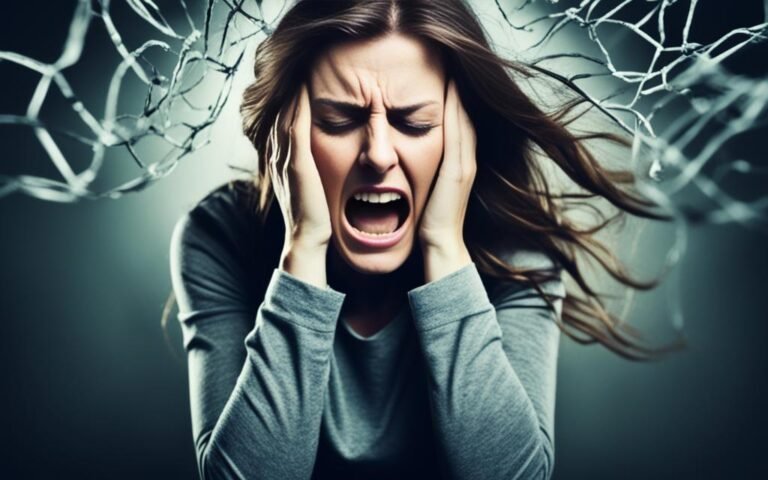Have you ever experienced that unsettling feeling when anxiety takes hold of your body, causing your hands to tremble and your heart to race? It’s a feeling that I know all too well. As someone who has struggled with anxiety-related shaking, I understand how distressing and disruptive it can be to everyday life. But here’s the thing – you don’t have to let anxiety control you. How to stop shaking from anxiety? There are effective techniques to reduce shaking caused by anxiety and regain a sense of calm and control.
In this article, I want to share with you some valuable insights and practical tips to control anxiety-related shaking that can make a real difference. Through personal experience and extensive research, I’ve discovered various natural remedies for shaking anxiety, self-help strategies, and lifestyle adjustments that have helped me find relief.
Whether you’re dealing with occasional bouts of anxiety or chronic anxiety, these calming tips can provide you with a sense of empowerment and enable you to navigate the challenges of daily life with greater ease and tranquility. Together, let’s explore effective ways to stop shaking from anxiety and embark on a journey towards inner peace and well-being.
Key Takeaways:
- Shaking can be a common symptom of anxiety, but it doesn’t have to control your life.
- How to stop shaking from anxiety? There are effective techniques and strategies to help you stop shaking from anxiety.
- Natural anxiety shake remedies, self-help strategies, and lifestyle adjustments can help you in managing shaking caused by anxiety.
- By implementing these calming tips to control shaking from anxiety, you can find relief and regain a sense of calm and control.
- Whether you have occasional or chronic anxiety, these tips can empower you to navigate daily life with ease.
Understanding Anxiety-Related Shaking
In this section, we will delve deeper into the understanding of anxiety-related shaking. We will explore the biology of anxiety and how it relates to shaking, including the fight, flight, or freeze response. We will also distinguish between anxiety and panic disorders, highlighting their similarities and differences. Additionally, we will discuss the impact of chronic anxiety on the body, including its potential long-term effects on physical and mental health.
The Biology of Anxiety and Shaking
Anxiety is a natural response to stress, and shaking is one of the ways the body manifests this response. When you experience anxiety, your body releases stress hormones like adrenaline and cortisol. These hormones trigger the fight, flight, or freeze response, preparing you to protect yourself from perceived threats. Shaking or trembling can occur as a result of the body’s heightened physiological arousal during anxiety.
Distinguishing Between Anxiety and Panic Disorders
Anxiety disorders and panic disorders are related but distinct conditions. While anxiety disorders involve persistent worry and fear, panic disorders are characterized by sudden and intense episodes of panic. Shaking can be a symptom of both conditions, but panic disorders often manifest with more pronounced physical symptoms, such as a racing heart, shortness of breath, and chest pain.
The Impact of Chronic Anxiety on Your Body
Chronic anxiety can have significant effects on your body over time. Prolonged exposure to stress hormones can lead to physical symptoms such as muscle tension, headaches, and digestive issues. It can also negatively impact mental health, contributing to feelings of fatigue, irritability, and difficulty concentrating. Understanding the potential long-term effects of chronic anxiety underscores the importance of managing and addressing anxiety-related shaking.
| Effect of Chronic Anxiety on the Body | Physical Symptoms | Mental Health Symptoms |
|---|---|---|
| Muscle tension | Headaches | Fatigue |
| Digestive issues | Heart palpitations | Irritability |
| Sleep disturbances | Shortness of breath | Difficulty concentrating |
The Body’s Fight, Flight, or Freeze Response
The body’s fight, flight, or freeze response is a primal survival mechanism that prepares us to respond to perceived threats. When faced with stress or anxiety, the body initiates a series of physiological changes aimed at increasing our chances of survival. This response, also known as the stress response or anxiety response, is controlled by the autonomic nervous system.
During the fight, flight, or freeze response, the body releases stress hormones such as adrenaline and cortisol. These hormones trigger a cascade of reactions that prepare the body to either confront the threat, flee from it, or in some cases, freeze and play dead.
Physiologically, the body’s response to stress and anxiety can manifest in various ways, including increased heart rate, rapid breathing, heightened alertness, dilated pupils, and trembling or shaking. These physical symptoms are a result of the body diverting energy and resources to the muscles and vital organs, priming them for action.

Understanding the body’s fight, flight, or freeze response is crucial in managing and stopping shaking caused by anxiety. By recognizing that these physiological changes are a natural response to stress, individuals can work towards regulating their body’s reactions and calming the trembling or shaking that may occur.
How to Stop Shaking from Anxiety
What to do when the anxiety attack hits? How to stop shaking from anxiety? When anxiety strikes, it can often manifest as shaking, which can be uncomfortable and distressing. Luckily, there are practical tips and techniques that can help you regain control and reduce shaking caused by anxiety. In this section, we will explore three key self-help strategies for anxiety-related shaking: deep breathing techniques for immediate relief, mindfulness and meditation practices, and lifestyle adjustments for long-term management.
Deep Breathing Techniques for Immediate Relief
Deep breathing is a powerful tool that can help calm your nervous system and it is one of the ways to calm down trembling from anxiety. By focusing on your breath, you can activate the body’s relaxation response and bring a sense of calm to your mind and body.
One effective technique is diaphragmatic breathing:
- Find a quiet and comfortable place to sit or lie down.
- Place one hand on your chest and the other on your stomach.
- Inhale deeply through your nose, allowing your stomach to rise as you fill your lungs with air.
- Exhale slowly through your mouth, allowing your stomach to fall as you release the air.
- Continue this deep breathing pattern, focusing on the sensation of your breath filling and leaving your body.
Practicing deep breathing for a few minutes each day, especially during moments of intense anxiety or shaking, can provide immediate relief and help you regain control of your body and mind.
Mindfulness and Meditation Practices
Mindfulness and meditation are powerful practices that can help reduce anxiety-related shaking by promoting relaxation and calming the mind. By cultivating a non-judgmental awareness of the present moment, you can create space between yourself and anxious thoughts or physical sensations.
One simple mindfulness practice is body scan meditation. Here’s how you can try it:
- Find a comfortable position, either sitting or lying down.
- Close your eyes and bring your attention to your breath. Take a few deep breaths to center yourself.
- Start at the top of your head and slowly scan down through your body, noticing any areas of tension or discomfort.
- As you encounter these sensations, breathe into them and visualize them melting away with each exhale.
- Continue this practice, moving down through your body, until you reach your toes.
Regular mindfulness and meditation practices can help you develop a greater sense of calm and reduce anxiety-related shaking in the long term.
Lifestyle Adjustments for Long-Term Management
In addition to deep breathing techniques and mindfulness practices, making lifestyle adjustments can play a significant role in managing and reducing shaking caused by anxiety.
Consider incorporating the following habits into your daily routine:
- Exercise regularly: Engaging in physical activity can help release built-up tension and promote a sense of well-being. Aim for at least 30 minutes of moderate exercise most days of the week.
- Eat a balanced diet: Fueling your body with nutritious foods can support overall well-being and help regulate your mood. Include plenty of fruits, vegetables, whole grains, and lean proteins in your meals.
- Get enough sleep: Prioritize quality sleep to allow your body and mind to recharge. Establish a consistent sleep routine and create a conducive sleep environment.
- Reduce caffeine and alcohol intake: Both caffeine and alcohol can exacerbate anxiety symptoms, including shaking. Limit your consumption or consider alternatives like herbal tea or decaffeinated beverages.
- Practice stress management techniques: Incorporate activities such as yoga, journaling, or engaging in hobbies that help you relax and unwind.
By implementing these lifestyle adjustments, you can support your overall well-being and effectively manage shaking caused by anxiety over the long term.

Exercise: A Natural Remedy for Anxiety Tremors
Anxiety tremors can be distressing, but exercise can be a powerful natural remedy for reducing anxiety-induced tremors and promoting overall well-being. Physical activity not only helps to distract the mind from anxious thoughts but also has numerous benefits for anxiety relief. Incorporating regular exercise into your routine can have a profound positive impact on your mental health.
Exercise releases endorphins, which are natural mood boosters that can help alleviate anxiety symptoms. It also promotes the production of neurotransmitters like serotonin and dopamine, which are important for regulating mood and promoting feelings of calm and happiness. Additionally, exercise can help reduce muscle tension and promote relaxation, further reducing shaking caused by anxiety.
When it comes to choosing the right type of exercise for anxiety relief, it’s important to find activities that you enjoy and that suit your fitness level.
Here are some types of exercise that have been shown to be beneficial for managing anxiety:
- Aerobic Exercise: Activities such as running, cycling, swimming, or dancing can get your heart rate up and release tension, promoting a sense of calm and reducing anxiety tremors.
- Yoga: The combination of physical movement, deep breathing, and mindfulness in yoga can help relax the mind and body, reducing shaking caused by anxiety.
- Strength Training: Weightlifting or resistance training can promote a sense of empowerment and boost self-confidence, which can help reduce anxiety and promote overall well-being.
- Walking: Sometimes, a simple walk in nature can do wonders for anxiety relief. Being outdoors and connecting with nature has been shown to have a calming effect on the mind and body.
Incorporating exercise into your daily routine doesn’t have to be complicated. Start by setting realistic goals and gradually increase the duration and intensity of your workouts. Aim for at least 30 minutes of moderate-intensity exercise most days of the week.

Remember, exercise is just one piece of the puzzle when it comes to managing anxiety. It’s important to combine exercise with other self-help strategies and, if needed, seek professional help. By making regular physical activity a part of your routine, you can reduce shaking and find relief from anxiety tremors.
Tips to Control Shaking in the Moment
When anxiety strikes and shaking becomes uncontrollable, incorporating effective techniques to regain control can provide immediate relief. In this section, we will explore two powerful methods to help you manage shaking in the moment: grounding techniques for quick calm and progressive muscle relaxation.
Grounding Techniques for Quick Calm
Grounding techniques are simple yet effective strategies that can help bring you back to the present moment and reduce the intensity of shaking during an anxiety episode. These techniques work by redirecting your focus and attention away from anxious thoughts and physical sensations and toward your immediate surroundings. Here are a few grounding techniques you can try:
- 5-4-3-2-1 Technique: Identify and name five things you can see, four things you can touch, three things you can hear, two things you can smell, and one thing you can taste.
- Deep Breathing: Take slow, deep breaths, inhaling through your nose and exhaling through your mouth. Focus on the sensation of your breath as it enters and leaves your body.
- Sensory Distractions: Engage your senses by rubbing your hands together, feeling the texture of an object, listening to soothing music, or savoring a refreshing mint or piece of fruit.
Experiment with these grounding techniques and find what works best for you. Practice them regularly so that they become familiar and accessible tools in moments of anxiety-induced shaking.
Progressive Muscle Relaxation Explained
Progressive muscle relaxation (PMR) is a technique that involves tensing and relaxing different muscle groups to induce a state of deep relaxation. By systematically focusing on each muscle group, PMR helps release tension and reduce both physical and mental stress, including shaking caused by anxiety. Here’s how to practice PMR:
- Find a comfortable and quiet place where you can relax without interruptions.
- Starting from your toes, progressively tense and then relax each muscle group in your body. Hold the tension for a few seconds, then release and let go of the tension completely.
- Move systematically through your body, including your legs, abdomen, chest, arms, and face. Pay attention to how each muscle group feels when it’s tense and when it’s relaxed.
- As you practice PMR, focus on the sensation of relaxation and let go of any thoughts or worries.
Regularly practicing PMR can train your body to relax and release tension, making it easier to control shaking during anxiety episodes. It may take time and practice to master this technique, so be patient and persistent in your efforts.
Remember, both grounding techniques and progressive muscle relaxation are valuable tools for managing shaking in the moment. Incorporate these techniques into your self-care routine and tailor them to your specific needs. With practice and dedication, you can regain control and find relief from shaking caused by anxiety.

Natural Remedies and Supplements for Anxiety
In addition to lifestyle adjustments and therapeutic interventions, natural remedies and supplements can also play a role in managing anxiety symptoms and reducing shaking. While it’s important to consult with a healthcare professional before trying any new treatments, these natural options have shown promise in alleviating anxiety.
- Herbal Remedies: Certain herbs have been traditionally used to promote relaxation and reduce anxiety symptoms. Some popular herbal remedies for anxiety include chamomile, valerian root, lavender, and passionflower. These herbs can be consumed as teas, tinctures, or in supplement form.
- Supplements: Several supplements have shown potential in reducing anxiety symptoms. These include:
- Omega-3 fatty acids: Found in fish oil, omega-3 fatty acids have been linked to improved mood and reduced anxiety.
- Magnesium: Magnesium plays a role in regulating the body’s stress response and may help ease anxiety symptoms.
- L-theanine: Found in green tea, L-theanine has been found to promote relaxation and reduce anxiety.
- 5-HTP: 5-HTP is a precursor to serotonin, a neurotransmitter that influences mood. It may help alleviate anxiety symptoms.
- Ashwagandha: Ashwagandha is an adaptogenic herb that can help the body adapt to stress and reduce anxiety.
- Alternative Treatments: In addition to herbal remedies and supplements, alternative treatments such as acupuncture, aromatherapy, and massage therapy have been reported to provide relief from anxiety. These therapies aim to promote relaxation, reduce stress, and restore balance in the body.
It is important to note that natural remedies and supplements may not work for everyone.
Тheir effectiveness can vary. It is always recommended to consult with a healthcare professional before incorporating any new treatment into your anxiety management plan. Your healthcare provider can help determine the right approach for you and ensure that there are no interactions with any existing medications or conditions.
Remember, managing anxiety involves a holistic approach, and no single remedy will be a magic cure. It’s important to combine natural remedies, therapeutic interventions, and lifestyle adjustments to find the best strategy for reducing anxiety symptoms naturally.
When to Seek Professional Help
While self-help strategies and natural remedies can be effective in managing anxiety-related shaking, there are instances where seeking professional help is necessary for comprehensive treatment. It is important to recognize when your symptoms are significantly impacting your daily life and interfering with your ability to function. By consulting healthcare providers, you can access specialized care and personalized treatment plans to address your unique needs.
Therapeutic Interventions for Anxiety and Panic
Therapeutic interventions, such as cognitive-behavioral therapy (CBT) and eye movement desensitization and reprocessing therapy (EMDR), play a crucial role in managing anxiety and panic. CBT helps individuals identify and change negative thought patterns and behaviors that contribute to anxiety, while EMDR is effective in processing traumatic experiences and reducing anxiety symptoms. These evidence-based therapies, conducted by trained professionals, offer valuable tools and techniques to cope with anxiety and ultimately alleviate shaking caused by anxiety.
The Role of Medications in Managing Symptoms
Medications can be an important component of treatment for anxiety when symptoms persist and significantly impact daily functioning. Certain medications, such as selective serotonin reuptake inhibitors (SSRIs) and benzodiazepines, can help manage anxiety symptoms and reduce shaking. It is essential to consult with a healthcare provider who can evaluate your specific situation and prescribe appropriate medications if necessary. They will closely monitor their effects and make adjustments as needed to ensure optimal management of your anxiety symptoms.
Consulting Healthcare Providers for Personalized Treatment Plans
Every individual experiences anxiety differently, and what works for one person may not work for another. Consulting with healthcare providers, such as therapists, psychiatrists, or primary care physicians, is vital in developing personalized treatment plans. These professionals will assess your symptoms, provide a diagnosis, and recommend appropriate interventions tailored to your specific needs. They will work closely with you, monitoring your progress and making adjustments as necessary to ensure the best possible outcome in managing your anxiety-related shaking.
Seeking professional help is crucial in addressing anxiety-related shaking and finding a long-lasting solution. Therapeutic interventions, medications, and personalized treatment plans can provide the support and guidance needed to manage anxiety symptoms effectively. Remember, you don’t have to face anxiety alone; healthcare providers are there to help you regain control and live a fulfilling life free from the limitations of anxiety.
Conclusion
In conclusion, shaking can be a distressing symptom of anxiety, but there are effective strategies to help you regain control and find relief. Throughout this article, we explored the biology of anxiety and its connection to shaking, distinguishing between anxiety and panic disorders, and understanding the impact of chronic anxiety on your body.
To provide answer to the question about how to stop shaking from anxiety – we provided a range of techniques for immediate relief, such as deep breathing and mindfulness, as well as lifestyle adjustments for long-term management. Additionally, we highlighted the role of exercise as a natural remedy for anxiety tremors and discussed tips to control shaking in the moment through grounding techniques and progressive muscle relaxation.
Furthermore, we explored natural remedies and supplements that can help you managing shaking due to anxiety. However, it is always advisable to consult with a healthcare professional before trying any new treatments.
Remember, managing anxiety-related shaking is a journey, and it is important to find what works best for you. By implementing these calming tips and techniques, you can take steps towards reducing shaking, regaining control, and finding relief from anxiety.
FAQ
How can I stop shaking from anxiety?
There are several techniques you can try to stop shaking from anxiety. Deep breathing exercises, mindfulness and meditation practices, and lifestyle adjustments can provide immediate and long-term relief. It’s important to find what works best for you and incorporate these calming strategies into your daily routine.
What is the connection between anxiety and shaking?
Shaking can be a common symptom of anxiety. When you feel anxious, your body’s fight, flight, or freeze response is activated, leading to physiological changes that can include shaking or trembling. Understanding this link can help you better manage and stop shaking caused by anxiety.
How can I differentiate between anxiety and panic disorders?
Anxiety and panic disorders share similarities but also have distinct differences. Anxiety disorders involve a general sense of worry and fear, while panic disorders are characterized by sudden and intense episodes of fear or panic. A healthcare professional can help diagnose and differentiate between the two.
What are the long-term effects of chronic anxiety on the body?
Chronic anxiety can have various effects on the body, including increased stress hormones, weakened immune system, digestive issues, cardiovascular problems, and mental health disorders. Managing anxiety and seeking treatment can help minimize these long-term impacts.
How does the body’s fight, flight, or freeze response relate to shaking?
The fight, flight, or freeze response is a natural reaction to stress or perceived danger. During this response, the body releases stress hormones, increases heart rate and blood pressure, and tenses muscles. Shaking or trembling can occur as a result of this heightened physiological state.
What techniques can I use to stop shaking from anxiety in the moment?
Deep breathing exercises, such as diaphragmatic breathing, can help regulate your breathing and reduce shaking during anxiety episodes. Grounding techniques, like focusing on your senses or using a grounding object, can also provide quick calm. Progressive muscle relaxation, where you systematically relax each muscle group, can help relax the body and reduce shaking.
Can exercise help reduce shaking from anxiety?
Yes, exercise can be a natural remedy for anxiety tremors. Physical activity releases endorphins, which are natural mood boosters. Regular exercise can reduce anxiety symptoms, including shaking. Incorporating activities like walking, jogging, yoga, or dancing into your routine can be beneficial in managing anxiety-related shaking.
Are there any natural remedies or supplements that can help with anxiety-induced shaking?
Certain herbal remedies and supplements, such as lavender, chamomile, valerian root, and magnesium, have been used to alleviate anxiety symptoms. However, it’s important to consult with a healthcare professional before trying any new treatments or supplements.
When should I seek professional help for anxiety and shaking?
If anxiety and shaking significantly interfere with your daily life, it is recommended to seek professional help. Therapeutic interventions, such as cognitive-behavioral therapy (CBT) and eye movement desensitization and reprocessing therapy (EMDR), can be effective in managing anxiety and panic. Healthcare providers can also prescribe medications or create personalized treatment plans based on your needs.










